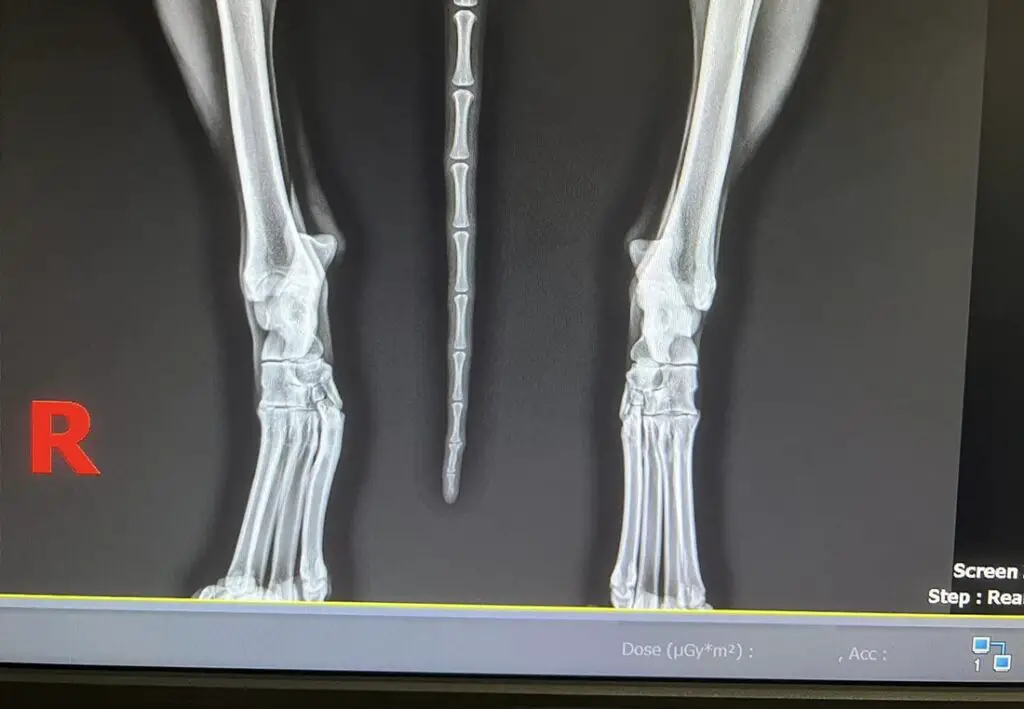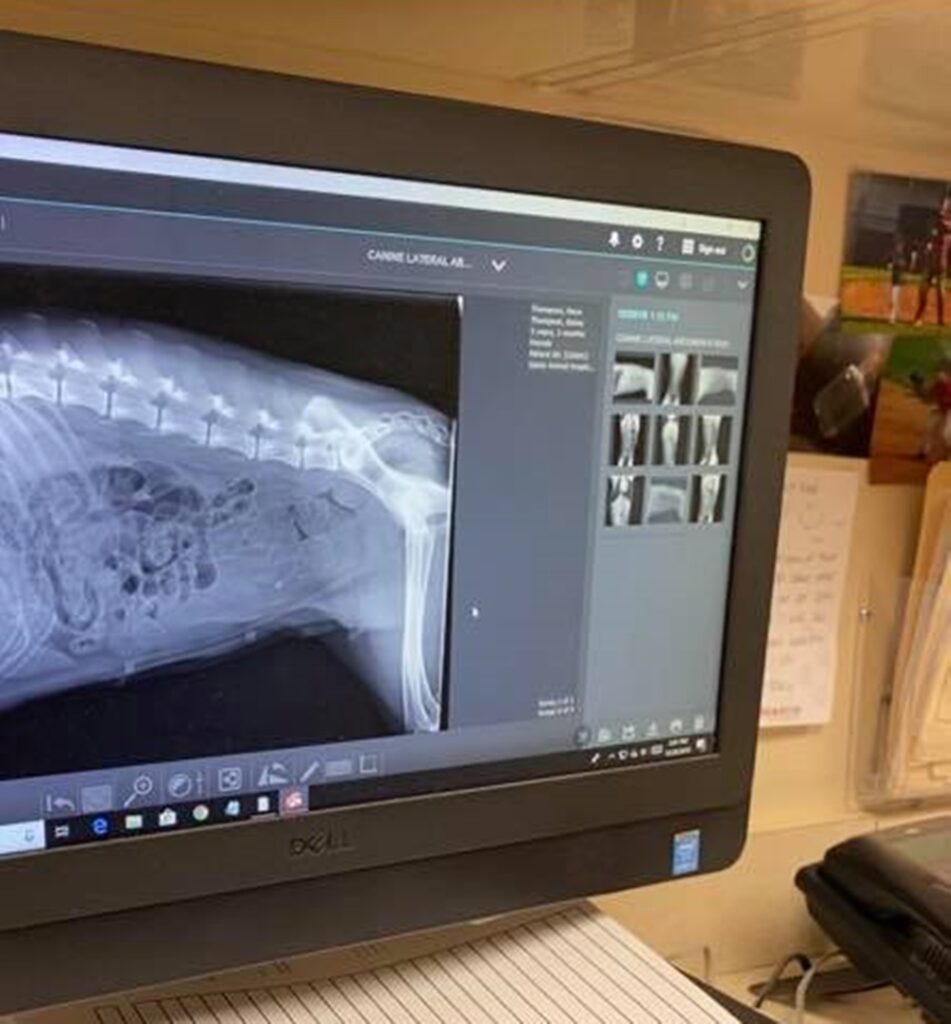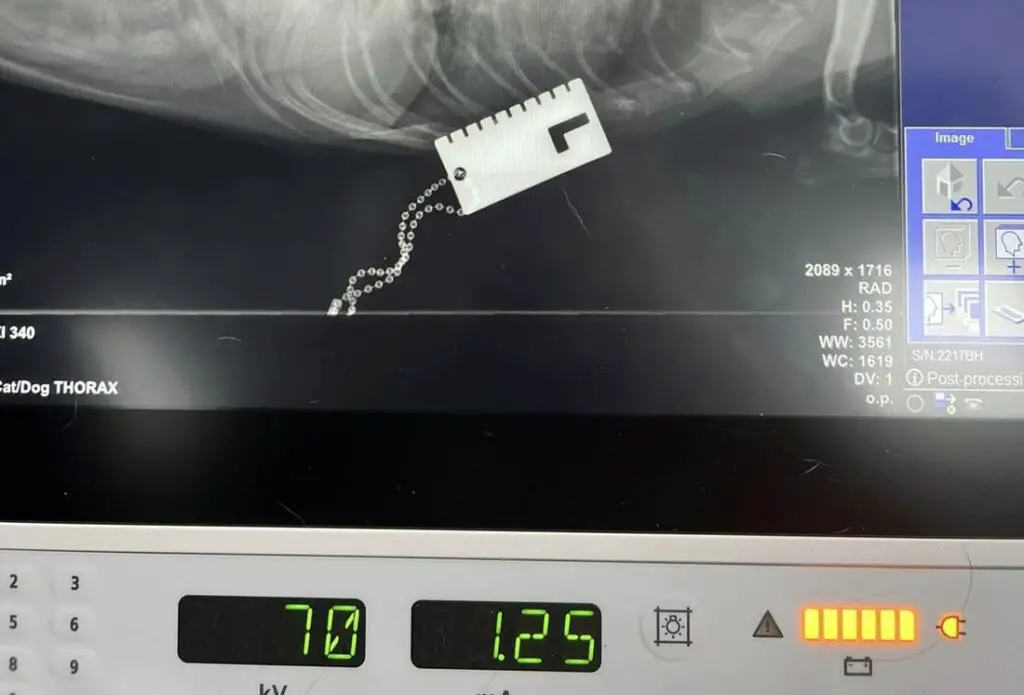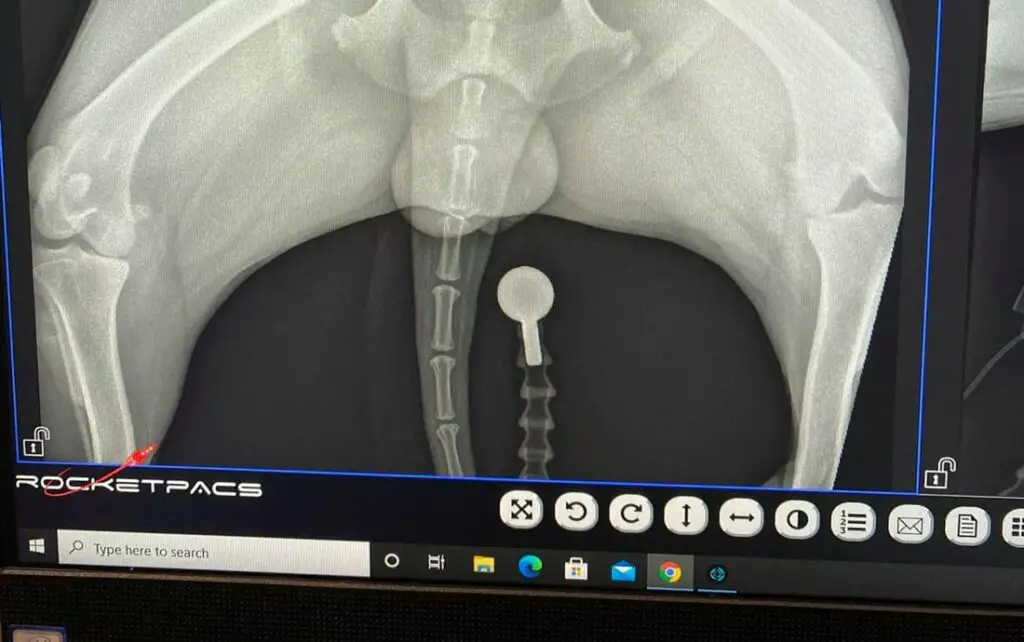X-rays are an important diagnostic tool for veterinarians to assess the health of your pet.
Dog X-rays can help identify fractures, tumors, and other abnormalities that may be difficult to detect through physical examination alone. It’s important to understand how much dog x-rays cost.
They can vary depending on a variety of factors such as location and type of imaging used. Here is how much dog X-rays cost.
- Key Takeaway
- What Is X-ray For Dogs
- How Much Do Dog X-Rays Cost
- What Affects A Dog X-Ray Cost?
- How Much Is An X-Ray For a Small Dog?
- Why Do Vets Charge So Much For X-Rays?
- Do Dogs Have To Be Sedated For X-Rays?
- How Long Does It Take For a Dog To Get An X-Ray?
- How Do Vets Take X-Rays In Dogs?
- Does Pet Insurance Cover X-rays?
- FAQs
- Conclusion and final thoughts
Key Takeaway
- An X-ray for dogs is a diagnostic procedure that uses radiation to create images of the internal structures of a dog’s body, providing valuable information about the health of bones, organs, and other tissues.
- The cost of dog X-rays can vary widely, typically ranging from $100 to $500 depending on factors such as the type of X-ray, the location of the veterinary clinic, and whether sedation is required.
- The cost of a dog X-ray is affected by several factors including the complexity of the X-ray, the geographical location of the veterinary clinic, whether sedation or anesthesia is needed, and the size and specific health condition of the dog.
- While sedation is not always necessary for dog X-rays, it may be required to ensure the dog remains calm and still, particularly if they are in pain or anxious, in order to obtain a clear image.
What Is X-ray For Dogs

An X-ray for dogs is a diagnostic imaging tool used to view the internal structures of a dog’s body, such as bones, organs, and other tissues.
An X-ray works by passing a controlled amount of X-ray radiation through the dog’s body, capturing an image of the structures inside.
The different tissues in the body absorb the X-rays to varying degrees. Bones, for example, absorb more X-rays and appear white on the image, while softer tissues like muscles or organs absorb fewer X-rays and appear darker.
In the veterinary field, we use X-rays for a variety of reasons. They can help us diagnose fractures, locate foreign objects, monitor the progression of a disease, or even evaluate the size and shape of the heart and other organs.
For instance, if a dog swallows a toy, an X-ray can show us exactly where the toy is lodged and help us determine the best course of action says Wikipedia.
How Much Do Dog X-Rays Cost

| Type of Scan | Average Cost Range |
|---|---|
| General Dog X-Ray | $126 – $300 |
| Dental X-ray (usually requires sedation) | Costs can vary, potentially higher due to sedation |
| Specific Injury/Illness X-Ray | $75 – $500 |
Dog X-rays typically cost between $75 to $500, averaging around $150 to $250, and if sedation or anesthesia is required, it can add an additional $40 to $200 to the total cost.
There are some things that can contribute to additional costs such as sedation or anesthesia, the location of the injury, and the number of x-rays needed.
X-rays are a vital tool for veterinarians when it comes to diagnosing and treating our canine companions. They provide important information about the internal structure and health of our pups. This allows vets to recommend the best course of action without having to resort to invasive procedures.
It is almost impossible to know the exact cost of X-rays until it is done. The vet can give you a base quote including the actual x-ray and sedation cost (if needed).
However, what they can not give you is the number of x-rays needed. They might not get the information they are looking for in the first shot and might need to get multiple viewpoints.
It’s important to know how much X-rays cost for dogs before you bring your pup in for an exam. In general, the prices will vary depending on the size and breed of your dog, as well as other factors such as breed-specific needs, the type of X-ray being done, and where you take your pup.
All of these factors can make it difficult to know the exact cost ahead of time. This is why asking the veterinarian is always your best bet.
What Affects A Dog X-Ray Cost?

The cost of a dog X-ray can be influenced by several factors, including the need for sedation, the location of the injury, the number of X-rays needed, and the geographic location of the veterinary clinic.
Sedation
Sedation is often necessary to keep the dog still during the X-ray procedure. The cost of sedation can vary depending on the type and amount of sedative used, and this can add to the overall cost of the X-ray.
From my experience, while sedation might increase the initial cost, it often results in better-quality images and a less stressful experience for the pet.
Location of Injury
The area of the body being X-rayed also affects the cost. Some areas, like the chest or abdomen, are more complex and may require multiple images from different angles.
This could lead to higher costs compared to a simpler X-ray, such as a limb.
Number of X-Rays Needed
The number of X-rays needed will directly impact the price. If multiple images or views are required to fully evaluate a condition, the cost will be higher.
For instance, in cases where we suspect a fracture, we often need to take X-rays from multiple angles to get a full understanding of the injury.
Geographic Location
Lastly, your geographic location can significantly influence the cost of veterinary services, including X-rays. Vet clinics in urban areas or regions with a higher cost of living may charge more for their services than those in rural or lower-cost-of-living areas.
In my practice, I’ve seen how the cost of running a clinic, from rent to staff salaries, can differ greatly between locations, and these costs are reflected in our prices.
How Much Is An X-Ray For a Small Dog?

The cost of an X-ray for a small dog typically ranges between $100 and $250, depending on the complexity and type of X-ray.
The price of an X-ray can vary widely based on several factors. These can include the area being X-rayed, whether sedation is required, and the facility’s pricing structure.
For instance, if your small dog needs a simple chest X-ray, it might be on the lower end of the cost range.
However, if the X-ray involves a more complex area such as the abdomen, or if your dog needs to be sedated for the procedure, the cost could be higher.
It’s important to remember that while cost is a consideration, the value of an X-ray in diagnosing and treating your pet’s health issues is immense.
In my experience, I’ve seen how X-rays have been crucial in identifying hidden health problems in small dogs, from swallowed objects to heart conditions.
So, while the upfront cost might seem significant, it’s a worthwhile investment in your pet’s health and well-being.
Why Do Vets Charge So Much For X-Rays?
Veterinary X-ray costs are driven by several factors that cover equipment, expertise, and operational expenses.
High Equipment and Maintenance Costs
One of the significant components of the cost for X-rays is the expense related to the equipment itself. X-ray machines are sophisticated devices, and their purchase, installation, and maintenance can be quite costly.
Furthermore, these machines must be regularly serviced and calibrated to ensure they’re operating correctly and safely, adding to the overall expenses.
Expertise and Time
The process of taking an X-ray requires a vet or a trained technician’s expertise. It’s not merely about positioning the animal and capturing an image.
The professional needs to accurately interpret the results, which requires years of training and experience. This expertise, combined with the time spent on the procedure, contributes to the cost.
Operational Expenses
Running a vet clinic involves many overhead costs, including rent, utilities, staff salaries, and insurance. These operational expenses are factored into the cost of every service provided, including X-rays.
Safety Measures
Safety measures also contribute to the cost. Protective gear, safe storage for radioactive materials, and proper disposal of hazardous waste are all necessary for the safe operation of X-ray services.
Do Dogs Have To Be Sedated For X-Rays?
Sedation is not always necessary for dog X-rays, but it is often used to ensure the pet’s comfort and safety and to get clear, accurate images.
The necessity of sedation largely depends on the dog’s temperament and the area of the body being X-rayed.
Some dogs are calm and can stay still long enough for the X-ray, while others may be anxious or uncomfortable, making sedation a better option.
Additionally, certain areas of the body, like the abdomen or chest, require the dog to stay very still to get a clear image, which might necessitate sedation.
In my experience, I’ve found that using sedation can often make the process smoother and less stressful for both the pet and the veterinary team. It allows us to capture better-quality images without causing undue stress or discomfort to the animal.
However, it’s always a decision made with the pet’s best interests in mind, considering factors like the pet’s overall health, age, and the specific circumstances of the X-ray.
How Long Does It Take For a Dog To Get An X-Ray?
An X-ray where the dog is sedated will take between 45 – 60 minutes and between 15 – 30 minutes without sedation. It usually takes around 15 to 20 minutes for a dog to become sedated after receiving a sedative.
X-rays provide invaluable information for veterinarians when it comes to identifying the origin of a health problem. Based on this, determining the next steps in treating an animal is easier.
When adding up prep time, the actual x-ray, review of results, and any necessary follow-up procedures, most dog owners can expect a complete session to generally last between 30 minutes to an hour.
A veterinary technician will typically escort your pup to an X-ray room equipped with a lead-free table and safety equipment such as a special shield to protect them from radiation. The vet will then place your dog in various positions. This way they can get a clear view of the area being examined.
After the images have been taken and sent to be examined, results are usually available relatively quickly, giving you one less thing to worry about regarding your fur baby’s health.
How Do Vets Take X-Rays In Dogs?
Taking X-rays in dogs involves a multi-step process that includes positioning the dog, capturing the image, and interpreting the results.
Positioning the Dog
The first step in taking an X-ray of a dog is to position them correctly. This usually involves placing the dog on a special table, with the X-ray machine positioned over the area to be examined.
Depending on the area being X-rayed, the dog may be placed on their side, back, or stomach.
In my experience, getting the dog into the right position can be one of the more challenging aspects of the process, especially if the dog is anxious or in pain.
Capturing the Image
Once the dog is positioned correctly, the X-ray machine is used to capture the image. The machine sends a controlled amount of X-ray radiation through the dog’s body, which is then captured on a digital sensor or photographic film on the other side.
Interpreting the Results
After the image is captured, it needs to be interpreted. This involves looking at the X-ray to identify any abnormalities that may indicate injury or disease.
As a vet, this is one of the most critical parts of the process. It requires a deep understanding of canine anatomy and a trained eye to spot any potential issues.
Does Pet Insurance Cover X-rays?
Pet insurance often covers X-rays as part of their policies, but the coverage can vary depending on the specifics of the policy and the reason for the X-ray.
Most comprehensive pet insurance plans typically include coverage for diagnostic tests like X-rays. These are usually covered when they’re necessary for diagnosing an illness or injury.
For instance, if a dog is limping and we suspect a fracture, the X-ray required to confirm this would typically be covered by a comprehensive pet insurance policy.
However, it’s important to note that not all pet insurance policies are the same.
Some may have certain restrictions or exclusions, such as not covering X-rays for pre-existing conditions or routine screening.
It’s always recommended to thoroughly review the terms and conditions of a pet insurance policy to understand what is covered and what isn’t.
FAQs
Q: Are There Any Hidden Costs Associated with Dog X-Rays?
A: Besides the basic fee for the X-ray itself, there could be additional costs for sedation, multiple images, emergency fees, or follow-up care. It’s important to discuss all potential charges with your veterinarian beforehand.
Q: How Can I Reduce the Cost of My Dog’s X-Rays?
A: One way to potentially reduce costs is through pet insurance, which can cover a significant portion of medical expenses. Additionally, some veterinary clinics might offer payment plans or sliding scale fees based on income. Don’t hesitate to discuss financial concerns with your veterinarian.
Q: Are Multiple X-Rays Necessary?
A: The number of X-rays required will depend on your dog’s specific health issue. While a single X-ray might be sufficient for some cases, multiple images from different angles may be necessary to fully assess certain conditions or injuries.
Q: What Are the Risks of Dog X-Rays?
A: X-rays are considered very safe for dogs. The level of radiation exposure is minimal and only poses a risk if repeated exposures occur frequently over a short period. The most common risk, though minimal, is an adverse reaction to sedation if it’s used.
Q: Can I Refuse an X-Ray for My Dog?
A: While you have the right to refuse any medical procedure for your pet, it’s important to understand the potential consequences. X-rays provide valuable information that can be crucial for accurate diagnosis and treatment. Refusing an X-ray could compromise your dog’s health care.
Q: Why Might My Dog Need an X-Ray?
A: Dogs might need an X-ray for various reasons, including diagnosing fractures, detecting foreign bodies, assessing organ health, screening for cancer, or even confirming a pregnancy. X-rays offer valuable insights into your dog’s internal health that aren’t visible from the outside.
Q: Will My Dog Need to Be Sedated for an X-Ray?
A: Sedation is not always necessary for X-rays, but it may be required if your dog is in pain, anxious, or unable to stay still for the images. Sedation ensures the safety and comfort of your pet and improves the quality of the X-rays by preventing motion blur.
Conclusion and final thoughts
An X-ray for dogs can cost between $75 – $500 depending on whether or not your dog will need to be sedated, the size of the dog, the severity of the injury the number of pictures needed, and overall the location of the clinic.
The X-ray process takes between 15 – 60 minutes depending on if sedation is required or not.



